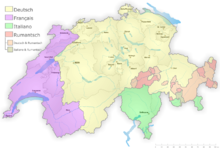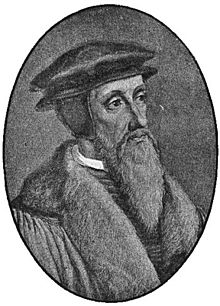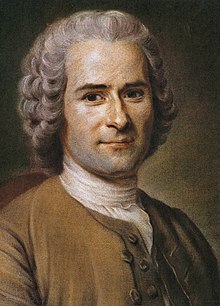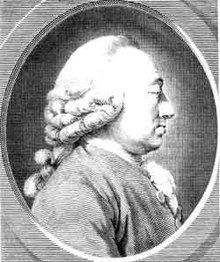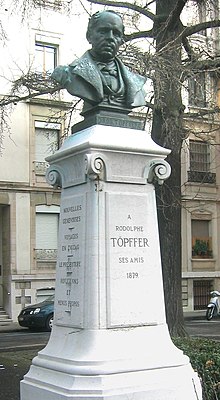Literature of the French-speaking Switzerland
The French-speaking Switzerland , often Romandie or Welschland called, covers the western part of Switzerland , namely the Protestant cantons of Geneva , Vaud , Neuchâtel , the Catholic cantons of Jura and the bilingual cantons of Friborg and Valais ; as well as parts of the canton of Bern .
Because the French-speaking cantons of Switzerland do not form a homogeneous unit, western Swiss literature combines numerous cultural influences, which on the one hand differ from those of the neighboring state of France , and also allow a different perspective in contrast to the other language regions of Switzerland.
The French language
However, this Romance language never had literary significance and soon had to give way to French, which had been the official and written language since the 13th century; However, it remained the language of the flat country for a long time (patois romand, see: Swiss French ) and actually only exists in literary terms in a few versions of the famous cattle row ( ranz des vaches ). Despite the common customs and language, however, political unity never existed among them, they belonged to different domains for a long time and there was no lack of jealousy and hostility among one another.
It was only since the founding of the Swiss federal state in 1848 that national awareness emerged from time to time, and it was only at this time that Switzerland started to develop national literature, although it cannot be denied that the main cities of Geneva, Lausanne, Neuchâtel and Friborg were also then on which the intellectual movement concentrated, pursued their special interests and, under the spell of the canton's spirit , opposed any centralizing direction with suspicion. Geneva has always played the leading role, partly because of its excellent location, partly because it became the headquarters of the French Reformation in the 16th century ; since then it has gained European importance.
Late Middle Ages
The time before the Reformation did not have much that was remarkable in literary terms. Some amiable poems by the brave knight Otto von Grandson from the 14th century (discovered and published by A. Piaget in 1889), chronicles that tell of the heroic deeds of the Swiss in the wars with Charles the Bold , several Mystères and Soties , some of which are already blown through by the Huguenot spirit, that is all. The most interesting personality is still the prisoner of Chillon , François Bonivard (1493–1570), whose chronicle describes the manly resistance of the city of Geneva against the power of the Duke of Savoy , and who had to atone for his convictions with long years of imprisonment.
reformation
Bonivard leads us right into the middle of the Reformation; for when he was given his freedom in 1536 as a result of the conquest of the Vaud by the Bernese, Guillaume Farel had already won the hearts of many Geneva citizens of the new doctrine and induced John Calvin to settle in Geneva, Farel went to Neuchâtel and founded the Reformation here; Pierre Viret , an able scholar, influential preacher and skilled polemist, worked in Lausanne .
Calvin
Calvin developed an astonishing activity in Geneva: he founded the Church in the face of enemies, made the Bible the basis of the state, purified morals, suppressed internal disputes, and, since he was actually more a humanist than a theologian, he honored and judged studies started higher education at the newly founded academy , where pastors, teachers and scholars for all of Europe were trained. He was a master of the French language (the French call him one of the fathers of their language) and his extensive literary activity has largely contributed to elevating Geneva to its influential position. The book trade experienced a colossal boom, the Reformation writings were printed not only for France, but also for Germany, Holland, England, and numerous humanists, such as Mathurin Cordier , Henri Estienne , Robert Estienne , François Hotman , Isaac Casaubon , Beroaldus u. a., stayed in Geneva either temporarily or permanently. There were also about 2000 refugees from France and Italy who brought their art and industry, but also their rigid republican ideas and the sad mood of exile. Calvin and his comrades in office ran a strict regime, and so it was inevitable that morals and lifestyle changed completely. The city took on a serious, sullen face: Church discipline was practiced with harshness , games and diversions, expense in clothing, food and drink were frowned upon, every sinful and indecent expression was severely punished.
Théodore de Bèze
After Calvin's death (1564), Théodore de Bèze was undisputedly the head of French Protestantism. In his youth he had devoted himself to other views, as his frivolous youth poems show; in Geneva, however, he had been defeated and converted by the powerful personality of Calvin and now worked for 42 years as a teacher and preacher with great success. In character, taste and inclination the opposite of his strict friend, as a writer not up to him, he surpassed him in grace and elegance; his numerous satirical and polemical writings show the brilliant speaker, and his psalm translation ( see Geneva Psalter ) is not without poetic momentum. In general, almost all literary activity in this period is in the service of religion, and on the other hand those who sacrificed to the muses are almost all pastors and pastors' sons. Beza's only tragedy, Le sacrifice d'Abraham , is nothing more than a haunting sermon, and the only poems that betray a poetic feeling are left by the Neuchâtel pastor Blaise Hory .
Further influence of the Reformation
Outside of this spell is the frosty allegorical play L'ombre de Garnier Stoffacher (1584), probably the oldest version of the Tell-Shot , and the numerous rhymes that tie in with the famous Escalade de Genève (1602); Samuel Chappuzeau's drama Genève délivrée (1662) is probably the most bearable. The Swiss wanted to count the brave Huguenot Théodore Agrippa d'Aubigné among their own, because he spent his youth and the last years of his life (1620–1630) in Geneva; only his poetic activity, especially his powerful tragiques , undoubtedly belong to France.
In the meantime, true to their principle, the reformers had set up schools everywhere, elementary schools in the villages, Latin schools in the cities, including the Académie de Lausanne . But the influx of strangers had decreased significantly; the Refugiés and the humanists turned preferentially to Holland and made this country the center of their literary activity.
The 17th and 18th centuries
The 17th century marked a standstill in the intellectual development of French-speaking Switzerland. The revocation of the Edict of Nantes in 1685 brought new blood to Geneva; this time science and math got the most benefit. The opposition to Calvinism also grew stronger and more sustained; While Sebastian Castellio , an opponent of the doctrine of predestination and apostle of tolerance ( Conseil à la France désolée ), had to go into exile 100 years earlier , now, under the influence of Jean-Alphonse Turrettini , professor of church history since 1694, and his friend Jean Frédéric Ostervald , author of the great catechism and a widespread translation of the Bible (1744), the practice of the Geneva Church was milder and more tolerant, and following the pietism that had come over from Germany, a liberal Protestantism could develop, which was described in Marie Huber († 1753) and in Béat de Muralt († 1749) his main representatives sand. Muralt is also the most remarkable writer of the time; his Lettres sur les Anglais et les Francais can be called the worthy precursors of the Lettres persanes by Montesquieu and the Lettres anglaises by Voltaire . The political and social parties, the negatifs, représentants and natifs, faced each other much more harshly; their disputes often had a bloody outcome and in some cases could only be settled with the help of abroad. This also explains the vast amount of political writings, satires and songs that were written during this time, but whose interest naturally passed with it.
Voltaire
Voltaire's stay had a decisive influence on the intellectual and moral development of French-speaking Switzerland. In December 1754 he settled near Geneva, partly attracted by the beautiful nature, partly by the excellent printing works in which many epoch-making works were printed at that time, and soon got into lively intercourse with some respected families, such as the pastors Vernet and Vernes, the famous doctor Théodore Tronchin and his two brothers, Professor Pictet, and enchanted everyone with his amiability; but when he tried to carry out his Zaire , he encountered stubborn opposition from the consistory ; Since Calvin's time, dramatic performances, other than sacred ones, had no longer been tolerated and even private performances had been punished.
Wounded in his vanity, he turned to Lausanne and found better accommodation there, especially with women; Even the pastors did not hesitate to attend the societies and performances of the witty mockers. When he returned to Geneva, he decided to take revenge on the musings; Some biting articles in the Encyclopédie and writings critical of religion, such as Poème sur le désastre de Lisbonne and later Candide, ou l'optimisme , provoked the attacked to violent replies; and in order to hit his opponents at the most sensitive point, he had a theater built on his Ferney estate on the border of the Geneva area and staged his plays there (including Tancrède ), for which the Geneva Society once again provided actors and an audience.
Rousseau
Even Jean-Jacques Rousseau , Geneva's largest citizens, intervened in the dispute; If Voltaire had ties to the ruling class and had numerous supporters among the natifs, the democratic Rousseau stuck to the représentants, in the spirit of which he wrote the Lettres sur les spectacles against Voltaire . With the rate of the city, however, both had spoiled it: he had both the Candide and the Émile burned and Julie or The New Heloise forbade as immoral. Rousseau tried to justify himself with the Lettres de la Montagne , but this really fueled the dispute. Voltaire retained the last word (with Guerre civile de Genève ), and in 1782, after repeated intervention by the French ambassador, an actor troupe was introduced in Geneva and a stone theater was built; the first directors were Fabre d'Eglantine and Collot d'Herbois.
Boom in the natural sciences
Geneva
The natural sciences had made a brilliant upswing. Men like Gabriel Cramer , Jean-Louis Calandrini , Jean Jallabert , De Luc, Marc-Auguste Pictet , but especially Charles Bonnet and his famous nephew Horace-Bénédict de Saussure , drew the eyes of all of Europe through their observations, travels and research. There was also movement in other areas: in addition to the excellent historian Mallet, the librarian Jean Senebier must be mentioned, who wrote a literary history of Geneva with great diligence, but little sense of style and little measured judgment.
Bern
Back then there were some excellent scholars in Bern who made good use of the German and French languages and therefore may be mentioned here: Albrecht von Haller , Karl Viktor von Bonstetten , Sigmund Ludwig von Lerber (1723–1783), the good one Verse made, and the bailiff Johann Rudolf von Sinner (1730–1787), who was valued as a translator, collector, archaeologist and bibliophile.
Lausanne

The Voltaire spirit had worked most in Lausanne. As the dependence on Bern closed the political career of the sons of the noble families, they had to leave the country if they felt the urge to work, often as educators of high-ranking personalities. These experiences, with their experiences abroad, the Vaudois with their easy-going and kindness, immigrant French and the numerous foreigners who came to the beautiful shores of the lake from year to year in increasing numbers, formed a kind of cosmopolitan society in which the witty sociability the Parisian salons were imitated with luck. One of the most interesting guests was the Englishman Edward Gibbon , the main magnet was the famous doctor Victor Tissot , whose Avis au peuple de la santé had 15 editions in a short time and was translated into 17 languages. Writing has become a fashionable thing among women since Isabelle de Montolieu's novels and translations had received much applause, especially Caroline de Lichtfield (1786), still the most enjoyable of all, who was also translated into English. The poésies helvétiennes by the dean Jean-Louis-Philippe Bridel , in which a national spirit can be felt every now and then, are somewhat higher . But he lacks precision and clarity of expression, and his poetic feel is not real.
Neuchâtel
Spiritual life also made itself felt in Neuchâtel at that time; here it was Isabelle de Charrière , a Dutch woman by birth, the author of the Lettres neuchâteloises and Lettres de Lausanne ( praised by Sainte-Beuve ), and the excellent critic David Chaillet (at the Mercure suisse ), who had a small but lively circle around them to which Benjamin Constant belonged for a while.
Helvetic and mediation time
During the French Revolution and the Empire, France absorbed all of Switzerland's interests and forces, especially since the proclamation of the Helvetic Republic and the act of mediation bound it closely with the neighboring country. Of the Swiss who were politically and literarily active for France at this time, the following are to be mentioned: the banker and minister Jacques Necker , the Baron Peter Viktor von Besenval , whom Sainte-Beuve calls next to Benjamin Constant the most French of all Swiss, the two theologians Etienne Salomon Reybaz and Etienne Dumont , friends of Mirabeau who often provided him with the concepts for his speeches, Benjamin Constant, the friend of Germaine de Staël , General Antoine-Henri Jomini , the famous military writer.
Germaine de Staël
Germaine de Staël was born in Paris and French in taste and habits, but by nature a Swiss woman, a real "daughter" of Rousseau and with a more Germanic nature in ideas and feelings, and so quite suited to the cultural mission of French-speaking Switzerland to meet, to mediate between the Germanic and Romanic peoples. Nevertheless, she did not want to know anything about Switzerland, and the stay in Coppet was a punishment for her, despite the wonderful nature and the interesting and brilliant society that came together there.
Restoration in Geneva
With the separation of Switzerland from France (1814) new spiritual life awakened, especially in Geneva; Here lived and taught the brothers Marc-Auguste Pictet and Charles Pictet de Rochemont , who founded the Bibliothèque britannique in 1796 , from which the Bibliothèque universelle emerged, the serious historian Jean Charles Léonard Sismondi , who was traveling with Corinna in Italy, the Geneva legislature Pierre-François Bellot , since 1803 also Bonstetten, the most French of all Bernese, who, as he said, only began to live here, and Madame Albertine Necker de Saussure , Germaine de Staël's cousin. The focus was Augustin-Pyrame de Candolle , whose extensive knowledge and cosmopolitan education exerted a great attraction on locals and foreigners. Special mention deserves Rodolphe Töpffer (1799–1846), the cheerful moralist and skilled caricaturist, the author of the Voyages en zigzag and the Nouvelles genevoises , who founded the Courrier de Genève (1841) with his friends . The Journal de Genève arose in 1826 from a group of young poets who came together in the Caveau Genevois and who cultivated political chansons; the most outstanding of them are Chaponnière (1769–1856) and Gaudi-Lefort. As these joined Béranger, so others joined Lamartine and Victor Hugo ; some of these died at a young age or got off in a soft, hazy direction; the most correct and elegant is Charles Didier (1805–1864), also praised as a travel writer, the most original Henri Blanvalet (1811–1870), who like Louis Tournier wrote pretty children's songs. Albert Richard (1801–1881) is considered the first national poet; with his accounts of outstanding events from the patriotic history, carried by great enthusiasm, he had great success with the youth, but was later forgotten.
regeneration
The circle around Petit-Senn in Geneva
The poet Jean-Antoine Petit-Senn (1792–1870) is a link between old and new Geneva (the dividing point is the revolution of 1846, with which completely new men came to government ); he had belonged to the Caveau, raved about the romantics and, from 1830 to 1836, had amused the people of Geneva with his joke paper Le Fantasque . His most successful poems are the humoresque La Miliciade on the Geneva city soldiers and the witty, perhaps too pointed rules of life: Bluettes et Boutades . Many younger people owe their inspiration and support to his hospitable house: the fable poet Antoine Carteret (1813–1889), the historian Albert Rilliet de Candolle (1809–1883), who checked the Tell and Rütli saga for authenticity, Henri-Frédéric Amiel ( 1821–1880), the intelligent poet and historian of the Geneva Academy, and Marc Monnier (1829–1885), professor of comparative literature at the University of Geneva since 1864, an extremely fruitful writer and soulful and formative poet, whose excellent Histoire générale de la littérature unfortunately only thrived up to the second volume.
One of the most outstanding poets of the new school was Philippe Godet (1850–1922), at the same time a brilliant literary historian and brilliant speaker; In addition to various volumes of his own poetry, he has edited the poems of the Freiburg poet Étienne Eggis and the Neuchâtel poet Alice de Chambrier .
Lausanne
In Lausanne, where strangers had previously set the tone, locals now took the lead in the intellectual movement; first and foremost Alexandre Vinet (1797–1847), the excellent literary historian and critic, the sympathetic preacher, the champion for tolerance and freedom of conscience and the poet of some beautiful hymns; then the patriotic poet Juste Olivier (1807–1876), who held a history professorship alongside Vinet for 12 years and exerted a profound influence on young students. The revolution of 1845 shocked both of their bodies; but while a benevolent fate soon took away from them, Olivier had to eat the bitter bread of exile and experience that his countrymen almost completely forgot him. It was from Paris that he wrote his heartfelt chansons lointaines , but neither these, nor his novels, nor the lectures he gave in Lausanne after his return (1870) were able to arouse the participation of the crowd. In addition to these, we should mention: Charles Monnard (1790–1865), the perfectly formed political speaker and publicist, Jean-Jacques Porchat (1800–1864), the ingenious and tasteful translator of Horace, Tibullus and Goethe; the historian Louis Vuillemin (1797–1875), the pastor of Vevey Alfred Cérésole (1842–1915), whose Scènes vaudoises (1885) were written in Vaud, Eugène Secrétan , the author of the Galerie suisse (1875) and president of a society, who made the systematic excavation of the ruins of Aventicum her task, and Eugène Rambert (1830–1886), the author of the Alpes suisses and excellent essays and biographies by Alexandre Vinet, Juste Olivier, Alexandre Calame and Emile Javelle .
Neuchâtel
Just as the revolution in Lausanne scattered the professors to the wind, it also brought an abrupt end to the brief heyday of the academy (only founded in 1839) in Neuchâtel in 1848. Here Olivier had taught before moving to Lausanne; but primarily geography and geology flourished; Men like Louis Agassiz , the founder of the glacier theory, Pierre Jean Édouard Desor , his colleague and the researcher of the pile dwellings and the Bronze Age (1811-1882), Arnold Guyot (1807-1884), Frédéric de Rougemont (1808-1876), a Students of Carl Ritter and Universal Geist, whose geographical handbooks have been translated into almost all European languages, worked together there and some found a second home in the New World after the revolution. The literary literature was poorly represented: the consistory exercised too strict censorship. In 1883 a number of young Swiss and French writers got together for the purpose of promoting the literary rapprochement between the two countries; its organ was the Revue suisse romande and its head Adolphe Ribaux (1864–1915), who published several volumes of Poésies . The poems left behind by a young woman, Alice de Chambrier (1861–1882), who died at the age of 21, caused an unusual sensation ; they were published by Philippe Godet under the title Au delà and had four editions in a short time; they are credited with depth of thought, elegant form, and energetic style, and complete lack of fuzzy sentimentality.
Catholic western Switzerland

The Catholic part of French-speaking Switzerland, Friborg and Valais, only played a minor role in literary terms until the end of the 19th century. In the first half of this century, the Jesuit Jean Baptiste Girard worked in Friborg , a liberal and unprejudiced man who gained general recognition for his practical and theoretical pedagogy and received the great Monthyon prize for his Cours de Langue . In 1841 the magazine L'Émulation was founded, which was for the Catholic part of Switzerland what the Revue suisse (founded in 1838, merged with the Bibliothèque universelle in 1861 ) was for the Protestant. Also worth mentioning are Pierre Sciobéret (1830–1876), a good storyteller, whose Scènes de la vie champêtre were published in two volumes by Ayer (1882 and 1884), and Etienne Eggis (1830–1867), an imaginative, graceful poet who how a bard wandered through Germany and wrote poems in the style of German boys' songs ( Poésies , 1885 edited by Philippe Godet).
20th and 21st centuries
In the 20th century, literature in the French-speaking area of Switzerland brought the poets Gustave Roud , Edmond-Henri Crisinel , Philippe Jaccottet , Jean-Georges Lossier and Pericle Patocchi , who came from Ticino but wrote all of his lyric work in French, as well Writers like Charles Ferdinand Ramuz and Jacques Chessex stand out. Blaise Cendrars and Charles-Albert Cingria were also from Switzerland.
Other well-known authors were S. Corinna Bille , Jean-Luc Benoziglio , Georges Borgeaud , Nicolas Bouvier , Maurice Chappaz , Pierre Chappuis , Albert Cohen , Anne Cuneo , Claude Delarue , Vahé Godel , Jeanne Hersch , Agota Kristof , Monique Laederach , Jacques Mercanton , Jean-Pierre Monnier , Alice Rivaz , Pierre-Alain Tâche and Yvette Z'Graggen .
The authors of the 20th and 21st centuries include Étienne Barilier , Alain de Botton , Markus Hediger , Élisabeth Horem , Pascale Kramer , Claire Krähenbühl , Yves Laplace , Daniel de Roulet , Olivier Sillig , Marie-Jeanne Urech and Alexandre Voisard .
Joël Dicker's novels have been translated into over 40 languages and sold in millions.
See also
literature
- Jürg Altwegg : Living and writing in French-speaking Switzerland. Portraits, conversations and essays from French-speaking Switzerland . Ammann, Zurich 1983
- Roger Francillon, Jacques Scherrer (ed.): Histoire de la littérature en Suisse romande . 4 volumes. Payot, Lausanne 1996-99
- Volume 1: Du Moyen âge à 1815 , ISBN 2-601-03182-4
- Volume 2: De Töpffer à Ramuz , ISBN 2-601-03183-2
- Volume 3: De la seconde guerre mondiale aux années 1970 , ISBN 2-601-03184-0
- Volume 4: La littérature Romande d'aujourd'hui , ISBN 2-601-03185-9
- Roger Francillon (Ed.): Histoire de la littérature en Suisse romande. Nouvelle édition . In one band. Éditions Zoé, Carouge-Genève 2015, ISBN 978-2-88182-943-7
Web links
- Roger Francillon: French-language literature. In: Historical Lexicon of Switzerland .
Individual evidence
- ↑ Andrea Kucera: The bestselling author next door In: Neue Zürcher Zeitung of September 29, 2015
